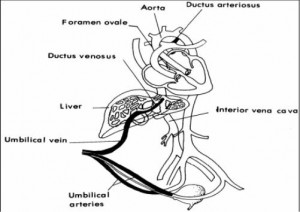
a. The umbilical vein is obliterated and becomes the round ligament of the liver.
b. The umbilical arteries are obliterated and ultimately become ligaments.
c. The ductus venosus is obliterated and becomes a ligament. Anatomic closure is completed at the end of 2 months. The ductus venosus is superficially embedded in the wall of the liver.
d. The ductus arteriosus is obliterated and becomes a ligament. Functional closure takes 3-4 days; anatomic closure is completed by 3 weeks. The constriction seems to be stimulated by a substance called Bradykinin, which is released from the lungs during their initial expansions.
e. The foramen ovale closes after the umbilical cord is tied and cut. A large amount of blood is returned to the heart and the lungs. With the lungs now functioning, there is equal pressure on both atria as the vessels constrict. Failure of the foramen ovale to close spontaneously results in an atrial septal defect, which may or may not require surgery later.
